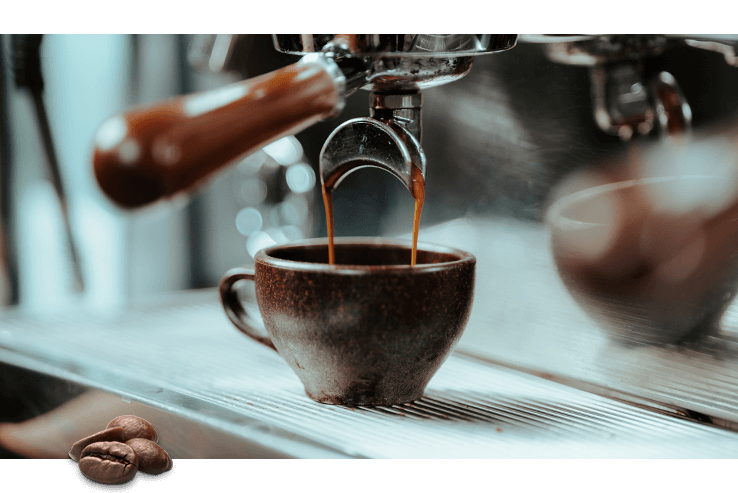Savor the True Quality with Freshly Roasted SOE Single Origin Espresso
Recognizing Coffee Beans: the Journey From Espresso to Blended Coffee Beans

The Beginnings of Coffee: A Worldwide Viewpoint
While you might believe of coffee as a modern staple, its origins map back centuries, linking with cultures across the globe. The story starts in Ethiopia, where tale says a goat herder called Kaldi uncovered the energizing impacts of coffee beans after seeing his goats romping energetically after eating them.
As trade paths broadened, coffee made its method to Europe in the 17th century, promptly obtaining popularity. Each society included its unique spin to coffee preparation, enriching its history.
Growing and Harvesting of Coffee Beans
As coffee's journey progressed, the emphasis moved to the farming and harvesting of specific bean varieties, particularly those used for espresso. You'll discover that coffee beans usually originate from Arabica or Robusta plants, each offering distinctive tastes. The optimal expanding problems consist of high altitudes and rich, well-drained dirt, which enhance the beans' quality.
Throughout the harvest, choosing techniques vary. In some regions, workers hand-pick ripe cherries, ensuring only the ideal fruit mosts likely to handling. In various other locations, mechanical harvesters are made use of, specifically on larger farms. Timing is vital; you desire to collect when the cherries reach peak ripeness for optimum taste.
As soon as collected, the beans are prepared for handling, which is vital in determining their last preference. Recognizing the cultivation and harvesting procedures provides you understanding right into what goes into your favorite coffee, improving your recognition for every cup.
Processing Approaches: From Cherry to Bean
Since you have actually discovered concerning gathering coffee beans, let's discover exactly how those cherries change into the coffee beans you enjoy. You'll see how various harvesting techniques influence flavor, adhered to by the necessary steps of fermentation and drying out. We'll damage down the milling and grading process that establishes your coffee's high quality.
Collecting Methods Explained
When it comes to coffee, recognizing harvesting techniques is important, given that they straight affect the flavor and quality of the beans you delight in. Discerning selecting involves hand-picking just ripe cherries, ensuring you get the finest high quality beans. Inevitably, the option of gathering technique can considerably affect your coffee experience, so it's worth knowing just how those beans made it to your cup.
Fermentation and Drying
After gathering, the next actions in handling coffee beans play a considerable function in forming their taste. You'll find that fermentation is important, as it helps break down the mucilage bordering the beans, enhancing their preference account. Relying on the approach, this process can last from a few hours to a number of days, with differing results based on temperature level and humidity.
Once fermentation is complete, drying adheres to, which is similarly important. You can select from sun-drying or mechanical drying methods. Sun-drying enables the beans to soak up tastes from the atmosphere, while mechanical drying out guarantees regular dampness levels despite weather condition. Appropriate drying out is vital to stop mold and protect the beans' high quality, inevitably influencing your mug of coffee.
Milling and Grading Refine
As fermentation and drying established the stage for flavor advancement, the milling and grading process assurances that only the very best coffee beans make it to your mug. This phase entails eliminating the outer layers of the coffee cherry, including the parchment and husk. After milling, the beans are sorted by dimension and weight, making sure an uniform high quality. You'll find that grading helps recognize defects and categorize beans, which affects flavor and aroma. High-quality beans receive a higher grade, leading to a richer coffee experience. As soon as graded, the beans are prepared for packaging and shipping, preserving their distinct qualities. This thorough procedure is important for supplying the remarkable preference you enjoy in every sip of your preferred mixture.
Roasting Techniques: Unlocking Flavor Possible
When you roast coffee beans, the technique you select can substantially impact the flavor account. Understanding the relationship between time, temperature level, and toasting techniques is crucial to exposing the capacity of your mixture. Let's discover exactly how these aspects collaborated to create the perfect cup.
Toasting Techniques Clarified
While you could believe that all coffee toasting methods generate the same outcomes, the fact is that each method discloses distinct taste potentials in the beans. Drum toasting uses a revolving drum to evenly distribute warmth, enhancing caramelization and generating a well balanced flavor. Air roasting, on the various other hand, circulates hot air around the beans, promoting a lighter roast with obvious acidity.

Influence On Taste Account
Different roasting approaches not only affect the procedure but likewise significantly influence the flavor profile of the coffee beans. When you select a light roast, you'll experience intense acidity and floral notes, showcasing the bean's beginning. In contrast, a medium roast balances level of acidity with sweet taste, typically revealing chocolatey undertones. Dark roasts, on the various other hand, highlight bold, great smoky flavors, occasionally concealing the bean's special qualities. Each technique discloses different oils and compounds, causing a vast array of flavors. By try out numerous toasting styles, you can discover which profiles resonate with your palate. Comprehending these more tips here subtleties aids you value the virtuosity behind your cup of coffee, enhancing your general experience with every sip.
Time and Temperature Level Variables
To launch the complete flavor capacity of coffee beans, both time and temperature level during the toasting procedure play significant duties. When toasting, you'll discover that higher temperature levels can quickly create tastes, however if you rush it, you could finish up with scorched notes. On the other hand, lower temperature levels permit a much more progressive flavor growth, showcasing the beans' one-of-a-kind attributes.

Timing is simply as essential; extending the roast too long can lead to a loss of level of acidity and illumination, while also short a roast might leave the beans underdeveloped. Discovering that wonderful spot requires method and trial and error. By adjusting these variables, you can expose the rich, intricate tastes hidden within each bean, producing a genuinely exceptional coffee experience.
The Art of Blending: Crafting One-of-a-kind Coffee Profiles

Beginning by picking a base coffee that provides a solid foundation. A brilliant Ethiopian bean can bring fruitiness, while an abundant Brazilian coffee includes body.
As you blend, remember that each mix informs a tale. You're not just making coffee; you're developing an experience. Take your time, taste regularly, and enjoy the journey of finding your trademark mix - Single Origin Espresso.
Developing Methods: Just How Prep Work Influences Taste
Mixing coffee opens up a domain of taste possibilities, yet exactly how you brew that mix can considerably influence your last cup. On the other hand, a pour-over highlights the coffee's clearness and brightness, excellent for showcasing delicate notes.
Coffee, with its high pressure, produces a concentrated shot that accentuates sweet taste and crema. If you choose a lighter mixture, think about a cool brew approach; it yields a smooth, much less acidic taste.
Adjusting variables like water temperature level, grind size, and brew time can change your coffee's profile. Accept the art of developing to discover the tastes concealed in your coffee blends.
The Future of Coffee: Sustainability and Advancement
As the coffee sector develops, sustainability and technology are becoming crucial for attending to ecological difficulties and conference consumer needs. You'll notice that even more coffee companies are embracing eco-friendly methods, from sourcing beans morally to executing sustainable farming strategies. These shifts not only aid the world yet likewise boost the quality of the coffee you appreciate.
You may see technologies like naturally degradable product packaging and water-saving brewing approaches that minimize waste. Advanced technology, such as blockchain, is additionally ending up being prominent, making sure openness in the supply chain, which enables you to map your coffee back to its beginnings.
On top of that, buying local neighborhoods and sustaining farmers via reasonable profession campaigns fosters a much more lasting coffee ecosystem. As you drink your following mug, bear in mind that your selections can contribute to a brighter future for coffee. By opting for sustainable brand names, you're not simply delighting in a beverage; you're making a positive influence on the globe.
Often Asked Concerns
What Is the Distinction Between Arabica and Robusta Beans?
Arabica beans are smoother, sweeter, and have a higher level of acidity, while robusta beans are stronger, much more bitter, and contain even more high levels of caffeine. When brewing your coffee., you'll see these differences in flavor and scent.
How Does Elevation Affect Coffee Bean Flavor?
Elevation influences coffee bean taste substantially. Higher altitudes create beans with brighter level of acidity and complicated tastes, while lower elevations usually generate beans that are heavier and much less nuanced. You'll notice these distinctions in your cup!
What Are the Wellness Perks of Drinking Coffee?
Consuming alcohol coffee can increase your power, enhance mental focus, and even boost physical performance. It's abundant in anti-oxidants, may decrease the risk of specific conditions, and can promote a much healthier metabolism when consumed in small amounts.
Can Coffee Beans Be Reused for Brewing?
Yes, you can recycle coffee beans for developing, however the taste could be weak. If you enjoy exploring, attempt my explanation reusing them in various ways, like cool brews or including in healthy smoothies for an extra kick.
Exactly how Should I Store Coffee Beans for Quality?
To keep your coffee beans fresh, save them in a closed container in an awesome, dark area. Avoid revealing them to heat, light, or moisture, as these variables can quickly weaken their taste and fragrance.
Comprehending Coffee Beans: the Trip From Espresso to Blended Coffee Beans.
Now that you've learned about gathering espresso beans, let's check out exactly how those cherries transform into the coffee beans you like.When you roast coffee beans, the technique you select can substantially influence the taste account - Single Origin Espresso.While you could assume that all coffee toasting techniques produce the exact same outcomes, the fact is that each strategy exposes one-of-a-kind taste possibilities in the beans.Various toasting approaches not just affect the procedure yet also greatly affect the flavor account of the coffee beans